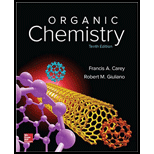
ORGANIC CHEMISTRY (LL)-W/SOLN.>CUSTOM<
10th Edition
ISBN: 9781259972348
Author: Carey
Publisher: MCG CUSTOM
expand_more
expand_more
format_list_bulleted
Concept explainers
Question
Chapter 13.16, Problem 24P
Interpretation Introduction
Interpretation:
The conversion of retrosynthesis to synthesis and the reagents that are required in each step for the following conversion is to be determined.
Concept introduction:
The addition of alkyl group to benzene results in the formation of alkyl benzene is done through Friedel Craft alkylation reaction.
In this reaction, the interference of a Lewis acid is required to initiate the respective reaction by withdrawing the halogen from an
This electrophile attacks on benzene ring and results in the alkylation of benzene ring along with the removal of respective hydrogen halide.
Expert Solution & Answer
Want to see the full answer?
Check out a sample textbook solution
Students have asked these similar questions
For a reaction to be spontaneous, the Gibbs Free Energy must be less than zero.
True or False
Which of the following reactions will be exothermic?
a) Reaction has enthalpy less than zero.
b) Reaction has enthalpy greater than zero.
c) Reaction has entropy less than zero.
d) Reaction has entropy equal to zero.
How many valence electrons are used in predicting the Lewis Dot structure of CH4?
a) 8
b) 6
c) 10
d) 2
Chapter 13 Solutions
ORGANIC CHEMISTRY (LL)-W/SOLN.>CUSTOM<
Ch. 13.2 - Based on Hammonds postulate which holds that the...Ch. 13.3 - Prob. 2PCh. 13.3 - Using : O =N+= O : as the electrophile, write a...Ch. 13.4 - Prob. 4PCh. 13.5 - Prob. 5PCh. 13.6 - Prob. 6PCh. 13.6 - Write a reasonable mechanism for the formation of...Ch. 13.6 - tert-Butylbenzene can be prepared by alkylation of...Ch. 13.6 - Prob. 9PCh. 13.7 - The reaction shown gives a single product in 88...
Ch. 13.7 - Prob. 11PCh. 13.8 - Using benzene and any necessary organic or...Ch. 13.10 - Prob. 13PCh. 13.11 - Prob. 14PCh. 13.12 - Prob. 15PCh. 13.12 - Prob. 16PCh. 13.13 - Prob. 17PCh. 13.13 - Prob. 18PCh. 13.14 - Reaction of chlorobenzene with p-chlorobenzyl...Ch. 13.15 - Prob. 20PCh. 13.15 - Prob. 21PCh. 13.15 - Prob. 22PCh. 13.16 - Prob. 23PCh. 13.16 - Prob. 24PCh. 13.17 - Prob. 25PCh. 13.18 - Prob. 26PCh. 13.19 - Write the structure of the expected product from...Ch. 13.20 - Prob. 28PCh. 13.20 - Prob. 29PCh. 13.21 - Prob. 30PCh. 13.21 - Offer an explanation for the observation that...Ch. 13.21 - Prob. 32PCh. 13 - Write the structure of the organic product in each...Ch. 13 - Prob. 34PCh. 13 - Prob. 35PCh. 13 - Prob. 36PCh. 13 - Prob. 37PCh. 13 - Prob. 38PCh. 13 - Prob. 39PCh. 13 - Treatment of the alcohol shown with sulphuric acid...Ch. 13 - Prob. 41PCh. 13 - Prob. 42PCh. 13 - Prob. 43PCh. 13 - Arrange the following five compounds in order of...Ch. 13 - Prob. 45PCh. 13 - Prob. 46PCh. 13 - Prob. 47PCh. 13 - Give reagents suitable for carrying out each of...Ch. 13 - Prob. 49PCh. 13 - Prob. 50PCh. 13 - Which is the best synthesis of the compound shown?Ch. 13 - What combination of acyl chloride or acid...Ch. 13 - A standard synthetic sequence for building a...Ch. 13 - Prob. 54PCh. 13 - Prob. 55PCh. 13 - Prob. 56PCh. 13 - Prob. 57PCh. 13 - Prob. 58PCh. 13 - Prob. 59PCh. 13 - Prob. 60DSPCh. 13 - Prob. 61DSPCh. 13 - Prob. 62DSPCh. 13 - Prob. 63DSP
Knowledge Booster
Learn more about
Need a deep-dive on the concept behind this application? Look no further. Learn more about this topic, chemistry and related others by exploring similar questions and additional content below.Similar questions
- How many valence electrons are used in predicting the Lewis Dot structure of CO2? a) 32 b) 26 c) 24 d) 16arrow_forwardHow many valence electrons are used in predicting the Lewis Dot structure of NO2? a) 17 b) 12 c) 5 d) 10arrow_forwardA compound that is bonded with an ionic bond is unlikely to dissolve in water. True or Falsearrow_forward
- In VSEPR Theory, AX6 is a) linear b) tetrahedral c) octahedral d) trigonal bipyramidarrow_forwardElectronegativity is the ability of an atom to attract an electron pair needed for covalent bonding. True or Falsearrow_forwardA single bond is called a) sigma bond b) pi bond c) hybrid bond d) hydrogen bondarrow_forward
- Predict the major organic products of the reaction below and draw them on right side of the arrow. If there will be no significant reaction, check the box below the drawing area instead. 田 m D H Cl H H There will be no significant reaction. + G હે Click and drag to start drawing a structure.arrow_forwardBased on the definitions for different types of bonding, which of these compounds should have the highest melting point? a) NaCl b) O2 c) CH4 d) N2arrow_forwardWhich of these compounds is held together by covalent bonding? a) CCl4 b) NaCl c) FeCl3 d) KBrarrow_forward
- In VSEPR Theory, AX4 is a) linear b) tetrahedral c) octahedral d) trigonal bipyramidarrow_forwardValence electrons a) form covalent bonds & are in the outer electronic shell b) form covalent bonds & are in the inner electronic shell c) hold ions together by electrostatic interaction d) are generally weaker than other bondingarrow_forward4 W X D de % F5 人 :0: > F6 1. Fill in the missing information 2. Na2Cr207 H2SO4, H20 OEt H₂O+ SOC2 CI SOCI C DELL OH 480 NEOH F7 B. F8 prt sc home end insert F9 F10 F11 F12 & * + VIX -4.arrow_forward
arrow_back_ios
SEE MORE QUESTIONS
arrow_forward_ios
Recommended textbooks for you
 Organic ChemistryChemistryISBN:9781305580350Author:William H. Brown, Brent L. Iverson, Eric Anslyn, Christopher S. FootePublisher:Cengage Learning
Organic ChemistryChemistryISBN:9781305580350Author:William H. Brown, Brent L. Iverson, Eric Anslyn, Christopher S. FootePublisher:Cengage Learning

Organic Chemistry
Chemistry
ISBN:9781305580350
Author:William H. Brown, Brent L. Iverson, Eric Anslyn, Christopher S. Foote
Publisher:Cengage Learning
